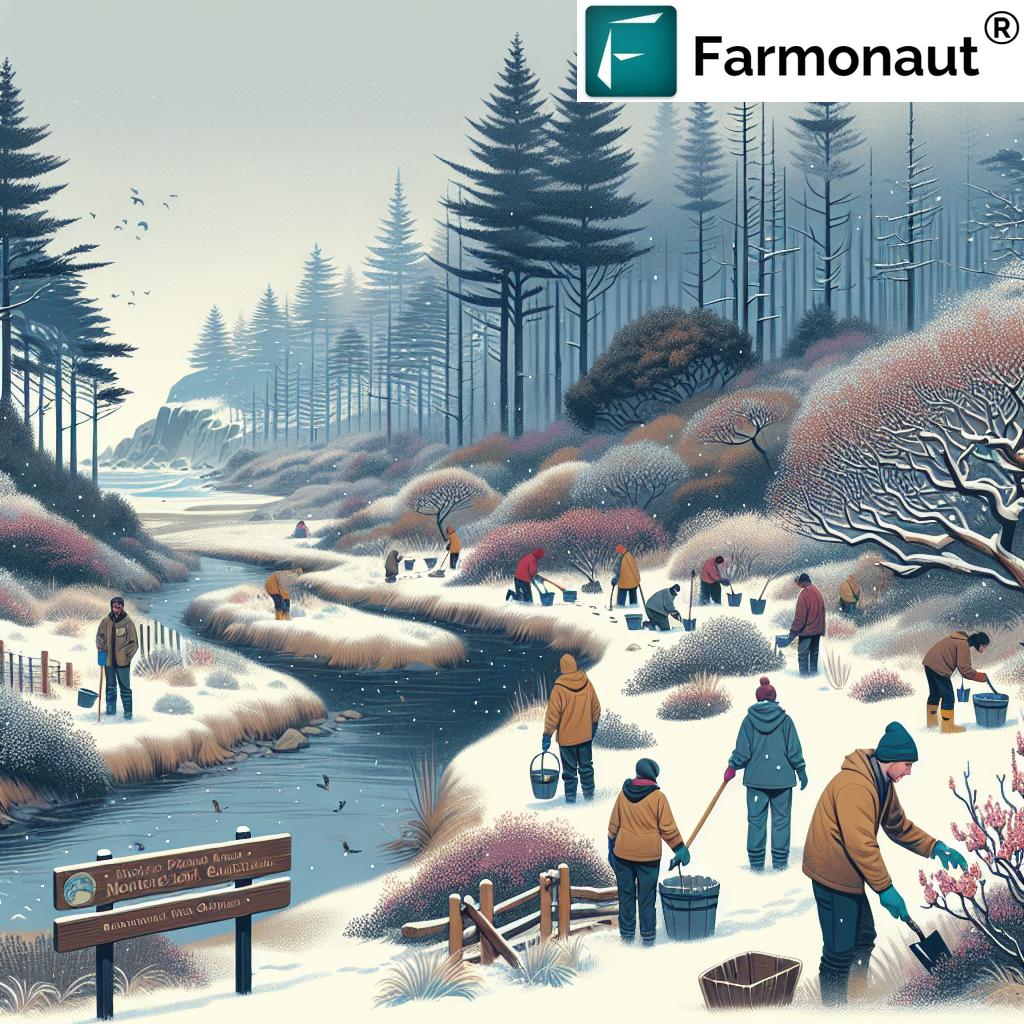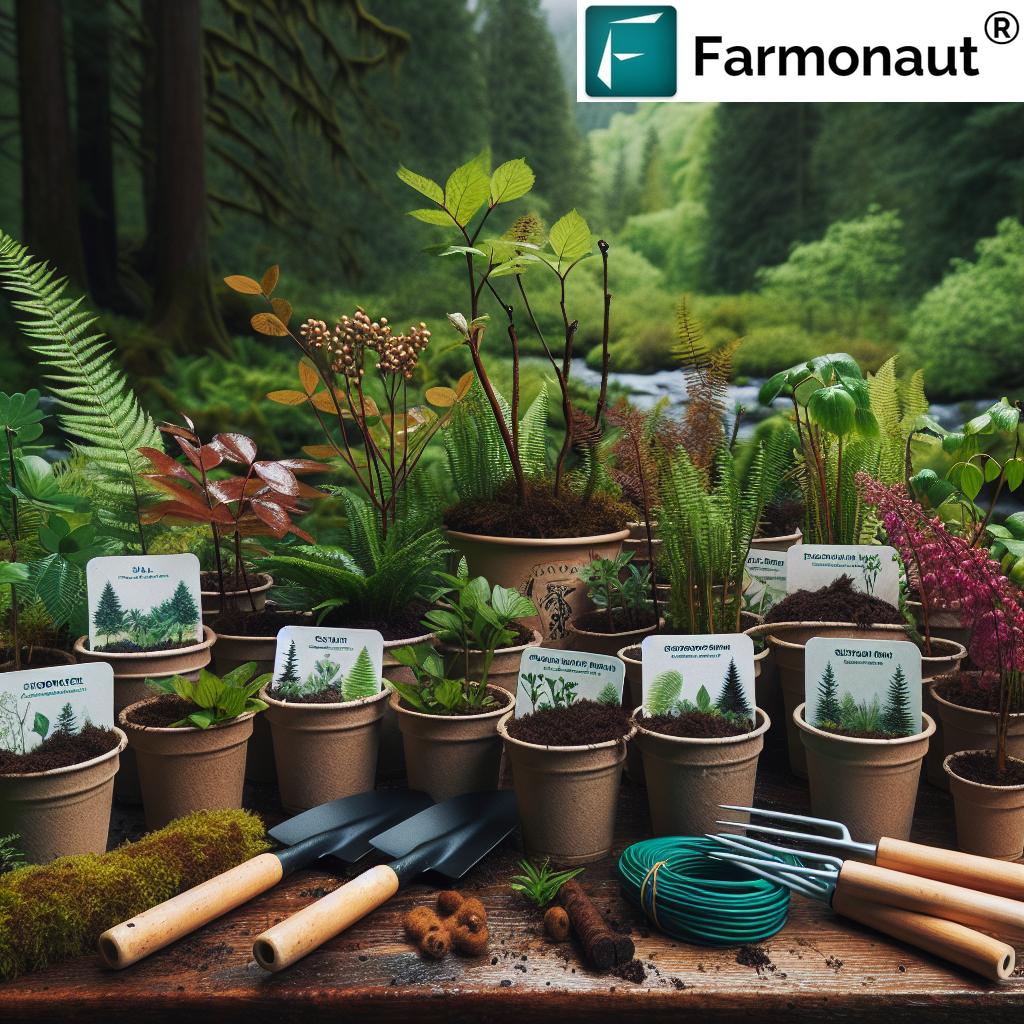Revitalize Snohomish County’s Ecosystem: Join the Native Plant Winter Planting Event at Picnic Point Beach
“Native plant restoration at Picnic Point Beach can reduce maintenance costs by up to 50% compared to non-native landscaping.”
Welcome to an exciting opportunity to make a lasting impact on Snohomish County’s ecosystem! We’re thrilled to invite you to join us for a native plant winter planting event at Picnic Point Beach. This conservation project offers a unique chance to participate in local ecosystem preservation while learning about the immense benefits of native species for our environment.

The Importance of Native Plant Restoration
Native plant restoration is a crucial aspect of maintaining healthy ecosystems. In Snohomish County, we’re facing challenges with invasive species and habitat degradation. By participating in this winter planting event, you’ll be contributing to the revitalization of our local environment and supporting a wide range of wildlife.
Here are some key benefits of native plant restoration:
- Improved wildlife habitat
- Enhanced soil stability
- Increased biodiversity
- Reduced maintenance costs
- Lower water consumption
As we work together to plant native species like Oregon grape, twinberry, and mock orange, we’re not just beautifying our landscape – we’re creating a sustainable environment that will thrive for years to come.
Event Details
The native plant winter planting event will take place at Picnic Point Beach on Saturday, March 1, from 11 a.m. to 1 p.m. This event is open to all ages and abilities, making it a perfect opportunity for families, friends, and community groups to come together and make a difference.
Here’s what you need to know:
- Date: Saturday, March 1
- Time: 11 a.m. to 1 p.m.
- Location: Picnic Point Beach, Snohomish County
- What to bring: Water, snacks, and weather-appropriate clothing
- Tools and gloves will be provided
Don’t miss this chance to be part of a meaningful conservation effort right in your backyard!
Native Plants: The Stars of Our Restoration Effort
During the event, we’ll be planting a variety of native species that are well-suited to the Snohomish County ecosystem. These plants play crucial roles in supporting local wildlife, stabilizing soil, and creating a resilient landscape.
Let’s take a closer look at some of the native plants we’ll be working with:
1. Tall Oregon Grape (Mahonia aquifolium)
The tall Oregon grape is a stunning evergreen shrub that offers multiple benefits to our ecosystem:
- Provides food for wildlife, including birds and small mammals
- Attracts pollinators with its bright yellow flowers
- Offers year-round ground cover, reducing soil erosion
2. Black Twinberry (Lonicera involucrata)
This native honeysuckle is a valuable addition to our restoration efforts:
- Supports streambank stabilization with its extensive root system
- Provides nectar for hummingbirds and other pollinators
- Offers shelter and food for various bird species
3. Mock Orange (Philadelphus lewisii)
The mock orange is a beautiful shrub that contributes to our ecosystem in several ways:
- Helps with erosion control on slopes and streambanks
- Attracts butterflies and other beneficial insects
- Provides nesting sites for small birds
“Snohomish County’s winter planting event aims to introduce over 1,000 native plants, including Oregon grape and twinberry.”
The Impact of Native Plants on Local Wildlife
By planting native species, we’re not just improving the aesthetics of Picnic Point Beach – we’re creating a thriving ecosystem that supports a wide range of wildlife. Native plants have co-evolved with local fauna, forming intricate relationships that are essential for biodiversity.
Here’s how our native plant restoration efforts benefit local wildlife:
- Provide food sources for birds, mammals, and insects
- Offer shelter and nesting sites for various species
- Support pollinators, including bees and butterflies
- Create corridors for wildlife movement
- Improve water quality for aquatic species
As we plant these native species, we’re laying the foundation for a healthier, more diverse ecosystem that will benefit generations to come.

Sustainable Landscaping Practices
Our native plant winter planting event is not just about restoring the ecosystem – it’s also an opportunity to learn about sustainable landscaping practices that you can apply in your own backyard. By incorporating native plants into your landscape, you can create a beautiful, low-maintenance garden that supports local wildlife and conserves resources.
Here are some sustainable landscaping tips you’ll learn at the event:
- Selecting native plants suited to local soil and climate conditions
- Implementing water-wise gardening techniques
- Reducing the need for chemical pesticides and fertilizers
- Creating wildlife-friendly habitats in your garden
- Proper planting and maintenance techniques for native species
By adopting these practices, you’ll not only contribute to the health of Snohomish County’s ecosystem but also save time and money on landscape maintenance.
Community Forest Stewardship: Your Role in Ecosystem Preservation
Participating in this native plant winter planting event is an excellent way to engage in community forest stewardship. As stewards of our local environment, we have the power to make a significant impact on the health and resilience of Snohomish County’s ecosystems.
Here’s how your participation contributes to community forest stewardship:
- Hands-on learning about native plant species and their ecological roles
- Direct involvement in habitat restoration and conservation efforts
- Building connections with like-minded community members
- Developing a sense of ownership and pride in local natural areas
- Inspiring others to get involved in environmental preservation
By joining us at Picnic Point Beach, you’re taking an active role in shaping the future of Snohomish County’s environment.
The Science Behind Native Plant Restoration
Native plant restoration is grounded in scientific research and ecological principles. Understanding the science behind our efforts can help us appreciate the long-term impact of this winter planting event.
Key scientific concepts related to native plant restoration include:
- Ecosystem services provided by native plants
- Soil microbiology and plant-soil interactions
- Genetic diversity and plant adaptations
- Succession and ecosystem dynamics
- Climate change resilience through native plant communities
During the event, our conservation experts will share insights into these scientific aspects, helping you understand the broader ecological context of our restoration efforts.
Preparing for the Winter Planting Event
To ensure a successful and enjoyable experience at the native plant winter planting event, it’s important to come prepared. Here are some tips to help you get ready:
What to Wear
- Dress in layers to accommodate changing weather conditions
- Wear sturdy, closed-toe shoes suitable for outdoor work
- Bring rain gear if the forecast calls for wet weather
- Consider wearing gloves for extra protection (though we’ll provide them)
What to Bring
- Water bottle to stay hydrated
- Snacks for energy during the planting session
- Sunscreen and a hat for sun protection
- Camera to document your conservation efforts
Parking and Transportation
Free parking is available at Picnic Point Beach, but spaces may fill up quickly. We encourage carpooling or arriving early to secure a spot. The event sign-in will be located at the west end of the parking lot near the pedestrian overpass of the BNSF railway.
The Long-Term Benefits of Native Plant Restoration
While the immediate impact of our winter planting event is visible, the long-term benefits of native plant restoration are far-reaching and significant. By participating in this event, you’re contributing to a range of positive outcomes for Snohomish County’s ecosystem:
- Improved water quality in local streams and lakes
- Enhanced habitat connectivity for wildlife
- Increased resilience to climate change impacts
- Reduced erosion and improved soil health
- Lower maintenance costs for public spaces
- Preserved natural heritage for future generations
These long-term benefits underscore the importance of ongoing community involvement in native plant restoration efforts.
Continuing Your Involvement in Conservation
The native plant winter planting event at Picnic Point Beach is just the beginning of your journey in conservation and ecosystem preservation. There are many ways to stay involved and continue making a positive impact on Snohomish County’s environment:
- Join local conservation groups and volunteer for future events
- Incorporate native plants in your home garden
- Educate friends and family about the importance of native species
- Participate in citizen science projects to monitor local ecosystems
- Support policies that prioritize environmental conservation
By staying engaged, you can help ensure the long-term success of our restoration efforts and contribute to a healthier, more sustainable Snohomish County.
Native Plant Benefits: A Comparison
| Native Plant Species | Environmental Benefits | Community Benefits |
|---|---|---|
| Oregon Grape |
|
|
| Twinberry |
|
|
| Mock Orange |
|
|
| Salal |
|
|
| Shore Pine |
|
|
| Sword Fern |
|
|
FAQs About the Native Plant Winter Planting Event
Q: Do I need any prior experience to participate?
A: No prior experience is necessary. Our experts will provide guidance and instruction throughout the event.
Q: Is this event suitable for children?
A: Yes, the event is family-friendly and open to all ages. It’s a great opportunity for children to learn about nature and conservation.
Q: What if it rains on the day of the event?
A: The event will proceed rain or shine. Please dress appropriately for the weather conditions.
Q: Can I bring my own tools?
A: While tools will be provided, you’re welcome to bring your own if you prefer. Please note that power tools are not permitted.
Q: How long does the planting session last?
A: The event is scheduled for two hours, from 11 a.m. to 1 p.m., but you’re welcome to participate for as long as you’re able.
Join Us in Revitalizing Snohomish County’s Ecosystem
The native plant winter planting event at Picnic Point Beach is more than just a day of gardening – it’s an opportunity to make a lasting impact on our local environment. By participating, you’ll be joining a community of dedicated individuals working together to preserve and enhance Snohomish County’s natural beauty.
Remember, every plant we put in the ground contributes to a healthier ecosystem, supports local wildlife, and helps create a more sustainable future for our community. We can’t wait to see you at Picnic Point Beach, ready to get your hands dirty and make a difference!
Together, we can revitalize Snohomish County’s ecosystem, one native plant at a time. See you at the event!
Ready to take your agricultural practices to the next level? Check out Farmonaut’s innovative solutions:
For developers looking to integrate agricultural data into their applications:
Download our mobile apps for on-the-go farm management:
Earn With Farmonaut: Join our Affiliate Program
Earn 20% recurring commission with Farmonaut’s affiliate program by sharing your promo code and helping farmers save 10%. Onboard 10 Elite farmers monthly to earn a minimum of $148,000 annually—start now and grow your income!
Conclusion: Be Part of the Change
As we wrap up this comprehensive guide to the native plant winter planting event at Picnic Point Beach, we hope you’re inspired to join us in this important conservation effort. By participating, you’re not just planting trees and shrubs – you’re investing in the future of Snohomish County’s ecosystem.
Remember, every native plant we introduce helps to:
- Restore natural habitats
- Support local wildlife
- Improve water quality
- Enhance community green spaces
- Build a more resilient environment
Your involvement makes a difference. Whether you’re a seasoned gardener or a first-time volunteer, your contribution is valuable and appreciated. Together, we can create a thriving, sustainable ecosystem that will benefit our community for generations to come.
So mark your calendars, gather your friends and family, and join us at Picnic Point Beach on Saturday, March 1. Let’s revitalize Snohomish County’s ecosystem, one native plant at a time!
See you there!



